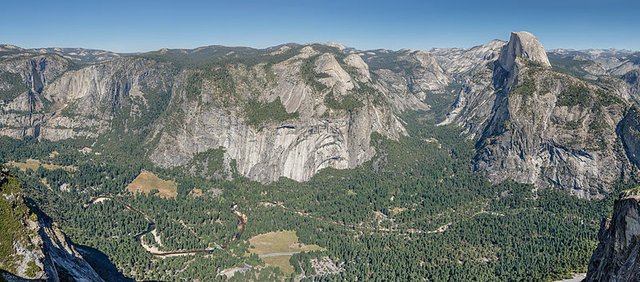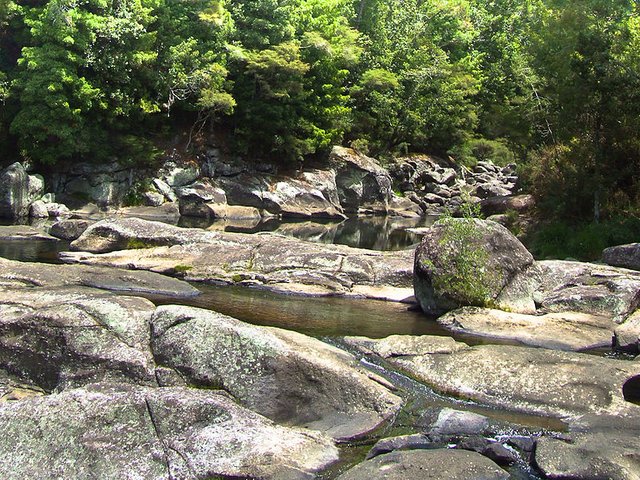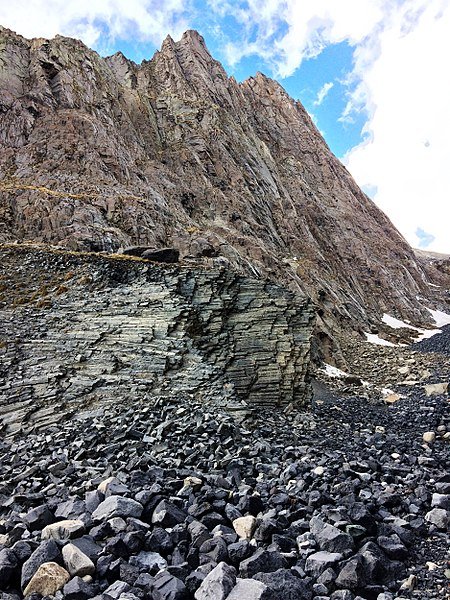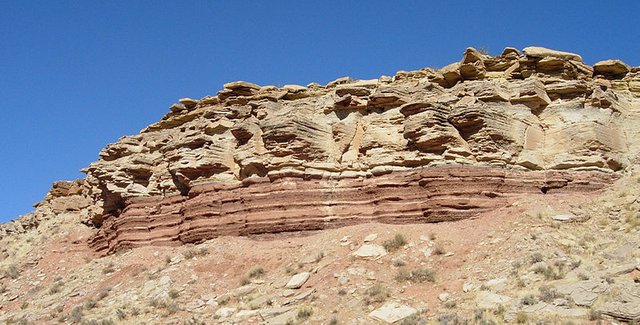HOMECOMING: ROCK BOTTOM AND HILLBILLY
Neither gods nor men will ever compel me to let you turn Casterly Rock into your whorehouse.' - Game of Thrones (Never mind this, just an effing random quote).

Wikimedia by Tuxyso CC BY SA 3.0
Hi Friends,
It's been like forever, right? Well, a lot happened to your home girl over the past weeks - some good experiences, bad events and some very ugly shit also happened. It's been one heck of a roller-coaster ride for me these few weeks gone past. But thank God, I am still here and I am back. So you are wondering if I wouldn't throw light on what transpired in the last couple of weeks. Truth is, as much as I want to, talking about the past stuff will be equivalent to writing an entire chapter of some random thriller novel. So we might as well just push past what happened and get on with what is happening now. But in seven words, I will say this much:
Cold. Accent. 8-5pm. Malaria. Cardiomegaly. Grasses. Rocks.
A lot of life packed into these seven words. I would rather we talk about one of them: rocks.
One person I would not forget in a hurry is Seun, the guy that sat beside me all through a long and exasperated journey from Lagos to Mangu in Jos. Seun was a sweet guy, really and this was not only because he was liberal with his food on the bus (yes, we shared a lot of what was meant to be his alone. I too like food). But more than that, Seun had no problem making a conversation and sharing useful knowledge that either centered on politics, oil wealth, the social anomalies in Nigeria and most importantly geology. I particularly enjoyed Seun's discourse about rocks because it was a thorough practical session. Passing through places like Lokoja, Abuja, Nassarawa, Kano, Katsina, Kaduna and their environs, it was impossible not to come across impressive displays of giant rock structures that took all different shapes and sizes. These rock mountains inspired a queer artistic dreaminess in me. It also led to a lot of questions and interactions with Seun that sort of kept me on the know about subjects that were erstwhile strange to me. In light of this, I would like to share some of the knowledge I garnered from my bus partner and friend.
The beginning of rocks

Wikimedia by QFSE Media CC BY SA 3.0
Have you ever thought about how rocks came to be? If you have, then you would admit that most times, it's easy to just think that rocks have always been there since life itself began. However, that's not the case. Rocks are formed through several organic ways. Before we can talk about how they are formed or how they first came to be, it is important to lay out the geological definition of a rock. A rock to a geologist is not just a hard lump that takes up a large space of our world, it's a natural matter that is made up of a several mineral resources that come together to form a solid chunk. Having said that, you would have already guessed that these solid lumps are consequences of some other existing substances in our world. Building on this, it is easy to infer that when some things come tog to make a reaction, a type of rock is formed. When yet another set of minerals fuse, another type of rock is created. This would naturally lead us to talk about the various types of rocks so we will know from whence they came from.
But first, it would be if interest to you to want to know about Earth's first rocks. The knowledge of the first rocks to inhabit earth was prompted by a study on the advent of water into Earth (You know, water was never always on earth. Earth was as dry as sandpaper when it first existed about four billion years ago. Ok, you are surprised now, right? We will talk about this next time.) A prolific geologist named Professor Stephen Mojzsis set about discovering the beginning of water by examining where water mostly love to sleep: on rocks. His research would have been made easier if he knew about more about the 'dark period' - a period about 500 million years ago when there were no rocks. It is believed that at that time, there were just massive mould of hot molten rocks.
However, in the year 2002, the professor made a ground breaking discovery. He discovered what is called zircon crystals in a large mass of crystal. These old minerals and the resultant rocky lumps could only have been formed in the presence of liquid water. Prof. Mojzsis tried to date back the zircon crystals by thoroughly examining the rocks and he found that the oldest zircon crystal was formed as far back as 4.4 billion years ago, that is even before dinosaurs existed. This means that rocks already existed when life existed and the presence of water on earth did not just occur in the near yesterday; these elements had been there for a much more longer time.
Rock formation: By their types, you shall know them
As I earlier stated, the various types of rocks we have largely goes a long way to explain how they were formed. Seun made a point of saying that it was rarely possible to identify a type of rock unless you felt and smelt them, but there were certain physical characteristics identified with each type of rocks. The igneous rock which in the Latin tongue means fire.

Wikimedia by Luka Adikashvilli CC BY SA 3.0
It is formed from the molten lava that comes from volcanoes. The rock crystallizes after an eruptive volcano melts and becomes magma. The melt or magma itself is a composition of several other rocks that existed before and were melted at the Earth's mantle. By cooling off, these previously solid rocks turned into a melt would form into rocks again through the process of fractional crystallization.
This whole process of hot rocks and crystallization is why we find igneous rocks at intra-plate hotspots, island volcanic sites and the ridges of mid ocean. Surprisingly though, this rock can be commonly found around us in the Earth's crust. Granites as we know it are igneous rocks as they form from magma that solidifies from the underground. These granites are found everywhere. One factor that contributes to their ubiquity is the fact that the floors of sea bodies are embedded with a dark lava kinda volcanic rock called Basalt.
One mountain that gives a profound history of the formation of igneous rock is Mount Etna in Italy. During a night eruption, the lava which erupts from the underground of Earth becomes solidified. And from the magma solidification, igneous is born.
Intermission
Wikipedia by Wilson Public Domain Licensed
The logic behind the formation of Sedimentary rock which is yet another type of rock is less complex. These rocks are formed from fragments of other broken down rocks. The eroded remains of the rocks broken down gather and pile up on lowlands and then due to some other materials and force around, they get compressed into sedimentary rocks. It is within this category that we have what Seun called sandstones and mudstones. If you've travelled through places like Lokoja or Abuja, even the hither parts of most Nigerian states, you will see a lot of these sandy hills and high brown rocks that look soft even from far.
These are sandstones that formed from the sandy sediments of former rocks on a beach or other bodies in a process called lithification. Most often, constructors have to break through these sandstones or mudstones to create roads. This is why you can sometimes see two identical sandstones in each side of the road. The phenomenon of cutting through sandstones is called road cut. And yes, I must not fail to mention that sedimentary rocks also form from broken animal and plant contents. It is from seashells that we have limestone and diatoms. Also, minerals that look bone-like emanate from water that are very rich in calcium. This is the more reason you can get fossils geologically referred to as strata from sedimentary rocks.
_3_(17270532516).jpg)
Common Wikimedia by James st. John CC BY SA 2.0
Metamorphic rocks which is the third and last type of rock is just as the name implies: a metamorphosis. What is undergoing metamorphosis or coming together in this case are igneous and sedimentary rocks. What must have occasioned the synergy between the two rocks are elements like heat, pressure or the penetration of fluids. The heat is most likely a result of a nearby magma or hot penetration from a hot spring. When metamorphic rocks are birthed from the altering and changing of the fabric of the igneous and sedimentary rocks, it becomes hard to distinguish or identify what they were before the alteration. Although metamorphic rocks are mostly found in mountain areas, a rather familiar is marble which is a metamorphosis of limestone.
I had so wanted to talk about the hillbilly country side of life in the places my eyes touched but there isn't anyway I can keep your attention if I write an epistle so a break here is only expected. But then when see as much lowlands, farm settlements, green hills and beautiful landscapes as I saw in places like Nassarawa and Jos, you will definitely be inspired to want to know more about topography and country life. Lagos us filled with too many unnatural scapes and architecture so that going to a place where the naturalness of landscapes are well preserved blows one's mind away. This aptly reminds me of the saying that when you leave a beautiful place, you carry it with you wherever you go. This is why the poetry of earth will never die. You can guess from the tone of my words that I synced well with the slow, green pace of country life but then internet is bae, Steemit is home. So yes, it feels so good to be back home.
References
Seun 😁
https://www.nationalgeographic.com/science/earth/inside-the-earth/rocks/
https://en.m.wikipedia.org/wiki/Formation_of_rocks

Nice write up maam, it was worth reading
I know you are good with poetry, can we have one ? #winks
Estastic! I love the diction!
Even tho I can still remember alot from the geography classes, you made me learn in a new dimension
I love the reference part 😂
Welcome back our stemng princess. Sorry you have to leave all those beautiful scenery and come back to the land of hustlers, Lagos.
Hi stemng daddy, you have been a great source of support to the whole lot of us. As always, I feel blessed to be back to my online family. Thank you @gentleshaid for welcoming me back.
Lol. True. Lag and overcongestion.
@pangoli, na true you talk oo. But then, lag is where the life is too
Really you want to cause a problem, you know there is another princess. Well i must confess she is good.
Welcome back @funmiakinpelu its nice having you back here and what a topic you chose to discuss this time, Rocks.
Geography was one of my favorite topics back in secondary school, reading about this topic brought back memories, thank you for that.
Hi @thurllanie, thanks for your comment. A lot of hugs from me 🤗🤗🤗🤗🤗🤗
Congratulations! Your post has been selected as a daily Steemit truffle! It is listed on rank 2 of all contributions awarded today. You can find the TOP DAILY TRUFFLE PICKS HERE.
I upvoted your contribution because to my mind your post is at least 24 SBD worth and should receive 212 votes. It's now up to the lovely Steemit community to make this come true.
I am
TrufflePig, an Artificial Intelligence Bot that helps minnows and content curators using Machine Learning. If you are curious how I select content, you can find an explanation here!Have a nice day and sincerely yours,

TrufflePigThis post has been voted on by the steemstem curation team and voting trail.
There is more to SteemSTEM than just writing posts, check here for some more tips on being a community member. You can also join our discord here to get to know the rest of the community!
She is a writer. 🥉
I would like to take this as a compliment @pangoli 😆
You're welcome